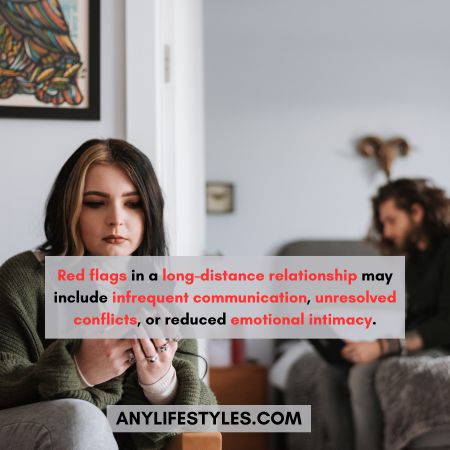In a long distance relationship, red flags can show if things might not be going well. Even though being apart can make a relationship stronger, it can also make problems more noticeable. This means that extra effort, trust, and communication are really important.
In this article, we will explore how to recognize long distance relationship red flags when loyalty is in danger, and what you can do to rebuild trust once it’s been broken. It is essential to recognize the signs early and address them before they become undefeatable.
So, dear readers, let’s dive in!
What Is a Red Flag in A Long Distance Relationship?
In long distance relationship, a red flag refers to a signal or indicator that suggests potential problems or challenges within the relationship. These flags could be behaviors, actions, or situations that raise concerns about the health and sustainability of the relationship.
Long distance relationship red flags might include things like infrequent communication, lack of transparency, unaddressed conflicts, or a decrease in emotional intimacy.

Recognizing these red flags is crucial, as they can serve as early warning signs that prompt necessary discussions and efforts to maintain a strong and thriving connection despite the physical distance.
Long Distance Relationship Red Flags
Making a long-distance relationship work means putting extra effort into talking and staying connected, not seeing it as a bad thing, but as a challenge to overcome. When obstacles arise in long-distance relationships, it can be harder to talk, and you might not want to or do it less often.
Recognizing the long distance relationship red flags is important, especially when you are not with your partner in person. This helps you fix any problems.
Stay connected with us to find out about six common long-distance relationship red flags.
1. Lack Of Communication – Long Distance Relationship Red Flags
In a long distance relationship, when communication starts fading away, it can become a concerning issue. When you and your partner don’t talk as much or as openly as before, it might lead to misunderstandings and distance between you.
The Trouble with listening, showing empathy, or discussing matters without hostility can indicate poor communication. However, regular and honest communication is essential in keeping the connection strong.

So, if there is a lack of it, it’s important to address the situation and find ways to improve your communication with each other. Also, practicing self-care can be beneficial in preparing for the discussion.
2. Lack Of Emotional Intimacy:
One common red flag in long distance relationship red flags is the consistent difficulty in sharing deep emotions. If both partners find it challenging to open up about their feelings, fears, and aspirations, It might show that they are not comfortable being open, and this could affect them emotionally.
When partners are hesitant to reveal their inner selves, it can make the relationship feel less meaningful. Additionally, limited mutual understanding can also signal an issue with emotional intimacy.
Also, if partners don’t get each other’s feelings, it could mean they’re not listening or understanding. True emotional intimacy requires not only sharing but also understanding and validating each other’s emotions, even from a distance.
3. Lack Of Trust:
Lack of trust in long distance relationship can lead to feelings of self-doubt. If your partner often gets jealous for no reason or accuses you of things you didn’t do, these are clear warning signs that trust is lacking.
Trust is like a key that keeps relationships strong, and it’s even more important when you’re far apart. Truly, without trust, long-distance relationships can struggle a lot.
Trust is like the solid base that holds up the parts of understanding, emotional connection, and staying committed, which are needed to deal with being far away from each other. So, taking care of trust by communicating openly, and supporting each other emotionally is important.
4. Gaslighting – Long Distance Relationship Red Flags:
Gaslighting is a way of communication that some people use to manipulate or take advantage of someone. In a romantic relationship, this might show up as one person ignoring the other’s feelings, blaming them and being critical of what they do, or saying they’re too sensitive.
Gaslighting can have really bad effects on mental health. When someone is made to doubt their thoughts and feelings all the time, it can lead to anxiety, feeling really bad about themselves, being depressed, losing control over their thoughts.
According to Fraser, “Gaslighting is targeted and consistent. It can make you doubt yourself a lot and feel insecure. It might even make you stay in a relationship that’s bad for you.”

5. Limited Social Media Presence:
Having a limited social media presence in a long-distance relationship can be a red flag to consider. If you have never been able to locate your partner’s Facebook profile, or if they don’t use other social media platforms, it’s worth being cautious.
In today’s digital world, almost everyone has some online presence, even if it’s just a little bit of information like their first and last name or where they live. It’s usually easy to find at least something about someone.
However, if your partner seems to have very little online presence, it might raise concerns. It’s important to pay attention to this aspect if you’re in a long-distance relationship, as limited social media activity could indicate a potential issue.
6. Lack Of Future Planning:
When things are going well in a long distance relationship, you usually make plans for visits and discuss how often you will see each other. However, if the planning phase starts to fade, or one person consistently avoids making plans and offers excuses, it’s a sign to be cautious.
This could indicate you and your partner drifting apart. It might reflect incompatible long-term plans. For instance, if one of you avoids discussing relocation or the future, the relationship might be fading without acknowledgment.
If you are uncertain about the future of your relationship, it is one of the major red flags in long-distance relationships. This uncertainty can lead to feelings of insecurity and doubt. To address this, open communication about your plans, hopes, and expectations is crucial.
7. Frequent Arguments – Long Distance Relationship Red Flags
Frequent arguments in a long-distance relationship can be concerning. While disagreements are natural, resolving them becomes more challenging due to the need for effective communication, patience, and empathy when miles apart.
Consistent arguing and bickering can signify deeper troubles. If disputes become habitual, addressing the core problems and finding solutions is vital. Taking responsibility for communication patterns and comprehending each other’s viewpoints is essential.
Experts recommend taking a 30-minute break when an argument escalates, particularly during phone or video conversations. This pause aids in calming the heightened emotions that often accompany such situations.

8. Unequal Financial Burdens:
Financial burdens within a long-distance relationship can be significant red flags. When one partner consistently bears the majority of the financial responsibilities for visits, communication, or other shared expenses, it can strain the relationship.
An equitable sharing of financial obligations is crucial for maintaining a balanced and healthy partnership. If the financial burden becomes one-sided and unsustainable, it may lead to feelings of resentment and inequality.
Open communication about financial expectations and finding solutions together is essential to prevent this issue from eroding the relationship’s foundation.
9. Non-Responsive Behavior:
In long-distance relationships, occasional unavailability due to busy schedules is understandable, but consistent patterns of this behavior may indicate deeper concerns. The dynamics of long-distance relationships naturally involve fluctuations, including different opinions on communication.
If your partner doesn’t often reply to your messages for a long time, it could mean they are not committed to the relationship. A good long-distance relationship means being nice to each other and talking to each other a lot.
When the person you care about neglects your messages, it could be a signal that they may not value the relationship as much as you do. Recognizing these patterns is vital for maintaining a healthy and balanced long-distance relationship.
10. Failure To Address Conflicts:
In the long-distance relationships, failing to address conflicts can be a significant red flag. When problems or disagreements arise and are left unattended, they can fester and grow into larger issues over time.
Ignoring these conflicts may signal a lack of communication or a willingness to avoid the tough conversations necessary for a healthy relationship. It’s crucial to address concerns openly and honestly in long-distance relationships to ensure they stay strong and resilient.

Ignoring conflicts can lead to a breakdown in trust and understanding, potentially jeopardizing the future of the relationship. So, recognizing and actively addressing conflicts is a vital aspect of maintaining a successful long-distance relationship.
11. Not Keeping Promises – Long Distance Relationship Red Flags:
In the context of long-distance relationship red flags, the issue of not keeping promises can be incredibly harmful. This behavior reflects a lack of commitment and reliability, two crucial elements in any relationship but especially critical when geographical distance separates partners.
When one consistently fails to uphold their promises, whether they are related to future visits, communication, or important life decisions, it breaks trust and leaves the other person feeling neglected and unimportant.
Individuals in long-distance relationships need to address this red flag promptly, engage in open and honest conversations about expectations, and work towards rebuilding trust through consistent and dependable actions.
12. Unwillingness To Take Responsibility:
An unwillingness to take responsibility is a concerning sign in a long distance relationship. When one person consistently avoids owning up to their mistakes or shortcomings, it can lead to frustration and conflict.
In a long-distance relationship, where effective communication and trust are vital, the unwillingness to take responsibility can hinder problem-solving and resolution. It might make the other person feel unsupported or like they are carrying the burden of the relationship alone.
Addressing this issue is crucial for maintaining a healthy long-distance relationship, as it fosters accountability and a sense of partnership, both of which are essential for its success.
Conclusion – Long Distance Relationship Red Flags:
In this article we explored common red flags, encompassing issues like communication problems, trust issues, and difficulties in future planning. These red flags should not be dismissed as they can indicate underlying challenges that might threaten the relationship’s health.
While long-distance relationships can be testing, acknowledging and addressing red flags is imperative for sustaining a strong and satisfying connection. Ignoring destructive or abusive patterns is a major red flag that should never be overlooked.
Both partners should invest their time, energy, and commitment into the relationship. Prioritizing mental well-being is essential, given the emotional challenges that distance can bring. It’s crucial to be aware of these emotional strains and seek support when necessary.
Each long-distance relationship is unique, and addressing issues promptly can lead to personal and relational growth. With dedication, trust, and effective communication, long-distance relationships can flourish despite the physical separation.










